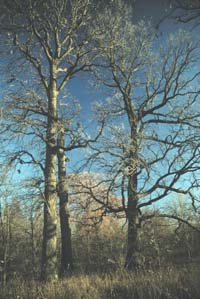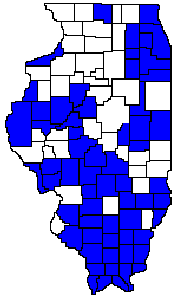 |
| Swamp
White Oak (Quercus bicolor)
Distribution
Map to Right |

Swamp white oak reaches a height of from 60-70 feet, with a trunk diameter of up to 3 feet. Its crown is open and broad, either rounded or irregular.
In Illinois, it occurs chiefly in bottomland woods and typically in flatwoods. Its range is north central and northeastern mixed forests where it occurs on wetter soils of floodplains, lowlands, and swamps that are periodically flooded.
Interesting
Facts
Swamp
white oak grows relatively rapidly and lives to be between 300 and 350
years of age. Whereas it prefers periodically saturated soils, swamp white
oak does not grow on sites that are continually flooded, and seedling growth
is best on better-drained soils versus continually flooded soils. Seedling
growth also requires open sunlight. Swamp white oak occurs with a variety
of species typical of wet forests, including red maple, American elm, sweetgum,
pin oak, and green ash, for example. It is usually not a dominant in these
forests, however.
Swamp white oak produces a large crop of acorns every 3-5 years, with lighter crops produced in the off years.
Identifying Features
Bark
Swamp white oak is in the white oak group. Its bark is light brown or gray, becoming darker brown with age. It is deeply fissured and flaky when mature.
Twigs
The twigs are grayish to reddish brown and slightly stout.
Buds
The buds are clustered at the tips of twigs. They are 1/8 inch long, elliptical to spherical, yellowish brown, and smooth to softly hairy at the tip.
Leaves
The leaves are alternate, simple, and 4-7 inches long, and 4 inches broad. They are oblong to ovate, with the widest portion of the leaf being toward the tip. The edges have large, rounded teeth, with a variable number and size of lobes. They are dark green, smooth, and shiny on the upper surface, whitish and often hairy beneath. The leafstalks are up to an inch long.
Flowers
Male and female flowers are borne separately, but on the same tree (monoecious). The flowers appear as the leaves unfold in the spring; the males as slender, drooping catkins, the female flowers in clusters of 2-4.
Fruits
The acorns occur in pairs on stalks up to 1 inch long. The acorns are 1 - 1 1/2 inches long, pale brown, and slightly hairy at the apex. The cup covers up to 1/3 of the nut and is slightly fringed.
Uses
The nuts
are sweet and nutritionally important for duck, turkey, songbirds, squirrel,
mice, and deer. The wood is hard, heavy and strong. It is used as a fuel
and in the manufacture of cabinets, interior finishing, and fence posts.
The Iroquois used swamp white oak to treat cholera, broken bones, and tuberculosis.